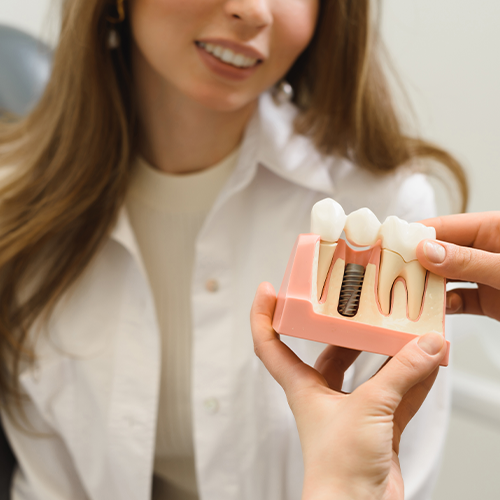
Dental implants are screw-like titanium devices implanted into the jawbone, then covered with dental crowns to replace the missing teeth. Crowns can be porcelain or zirconium, depending on the choice of the patient. The doctors will examine the teeth and gums, and the structure of the chin bone to recommend which type is more suitable. Implants are designed to replace the root of the teeth. Titanium material is compatible with the human body and it does not rust or rot. It is extremely durable and does not break, and they are immune to discoloration. Although the titanium implants usually last for a lifetime, the crowns that will be put onto the titanium implants need proper dental care.
In dental implant applications, artificial tooth roots made of a material such as titanium, compatible with body tissues, are placed in the jawbone with a small surgical procedure in a sterile environment. The implant, which fully adheres to the jawbone in approximately 2-3 months, becomes in a position to carry the prosthesis to be placed on top of it. Existing gaps can be closed by applying it to areas with missing tooth or multiple teeth. Dental implants enable patients who have lost their teeth to smile, talk, perform social activities, eat well and gain the most natural appearance of their teeth.
 Successful dental implants should have these qualities:
Successful dental implants should have these qualities:
- It should be done by dentists who are experts in their field.
- Implants that are compatible with the jawbone and allow rapid healing should be used.
- Applied implant should not cause tooth and gum diseases and bone loss.
- Materials that used should provide the closest appearance to the natural tooth.
Implants can be applied to different parts of the body. A dental implant is a type of implant applied inside the mouth. Before the implant treatment, on the basis of tomographic x-ray images, the compatibility of the implants with the bone structure is determined in advance and the roadmap of the procedures to be performed is drawn up. The duration of placing the implant in the patient's mouth varies according to the patient's bone structure, how many implants will be made, general needs and the operation to be performed. An operation can vary from 15 minutes to 1-2 hours. While the entire treatment can be completed in a single operation, it may be necessary to complete the treatment process with several operations.
Process of Dental Implant Applications:
One week after the implant is applied, the first controls are made and the existing sutures are removed. The next process, called "osseointegration", begins with the fusion of the bone and the titanium implant. Although recovery varies from person to person, the average time is between 2.5 and 3 months. At the end of 3 months, if there is no negative development in the gums, the process for prosthesis can begin. This process may take longer if sinus lifting or bone insertion procedures are performed. For example, a waiting period of up to 5-6 months may be needed. Today, with the development of advanced implant materials and new technologies, this process becomes much shorter, and in some cases, a temporary tooth is made on the day of the implant. At the end of 72 hours, a fixed prosthesis can be attached to the implants. This process is called rapid implant, in other words, we can say "immediate loading".

 Average length of stay
Average length of stay Length of stay in hospital
Length of stay in hospital Operation duration
Operation duration Anesthesia
Anesthesia Recovery Duration
Recovery Duration




